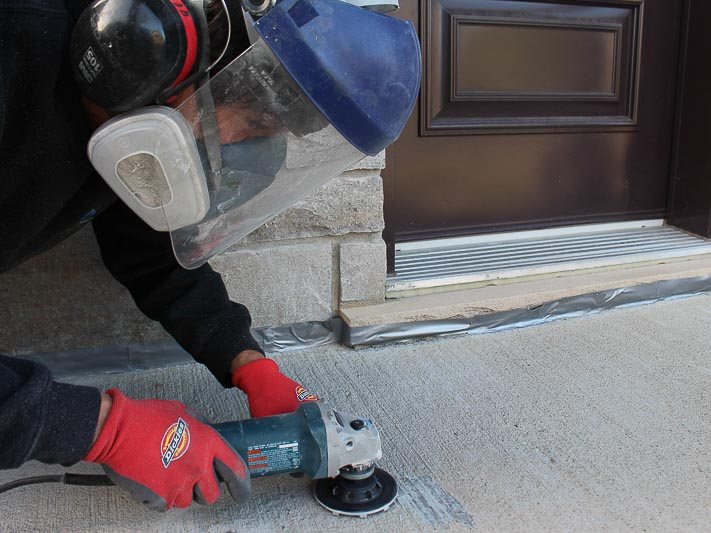How do I repair a concrete slab?
Concrete is an omnipresent building material in our lives.
Whether inside or outside our homes, concrete slabs are commonly used to create uniform, perfectly flat surfaces. You’ll find them in basements, on garage floors, patios and stoops, but also in the very architecture of our homes, in the form of staircases, curbs and sidewalks.
Concrete is renowned for its durability, with a life expectancy approaching a century. However, like all materials, it can suffer the ravages of time and its environment, becoming vulnerable to external elements and chemical aggression.
Common problems with concrete slabs
Common problems encountered with concrete slabs include cracking and spalling. Here is a list of these problems and their potential causes:
| Problem | Possible causes |
|---|---|
| Cracks | – Subsidence below the surface (compaction, backfill) |
| – Uplift (frost, tree roots) | |
| – Natural weathering shrinkage | |
| Crumbling | – Exposure to external chemical agents |
| – Permanent presence of water and humidity |
Call the concrete repair experts
While some homeowners consider carrying out the project themselves, calling in a professional guarantees uniform application and minimizes the risk of costly mistakes. Trust Prostationnement for your renovations.
How do I maintain and repair a concrete slab?
To understand how to intervene and repair a concrete slab, follow these steps :
-
Regular monitoring and maintenance:
- Keep an eye out for any blemishes on your concrete surface.
- Clean the concrete and, above all, remove any vegetation likely to cause cracks.
- Waterproof concrete exposed to the elements.
- Ensure adequate ventilation to avoid stagnant humidity.
- Clean up any corrosive spills.
-
Assessment of the Extent of Damage:
- Determine whether a repair is possible or whether replacement of the concrete slab is necessary.
-
Intervention with the right products:
- Choose appropriate products such as epoxy, polyurethane, silane, siloxane or water repellent.
- If you’re not sure how to proceed, call on our experts. They will be able to accurately diagnose the problems with your concrete slab and advise you on the solutions best suited to your situation.

Repairing a crack in a concrete slab
When faced with a crack in your concrete slab, it’s essential to follow a proper diagnostic and repair process.
Here are some tips on how to effectively repair a crack:
Diagnosis of cracked concrete slabs:
To determine whether your slab is repairable and choose the appropriate repair technique, start by identifying the exact nature and causes of the cracks.
-
Identify the type of crack:
- Faïençage: network of shallow, irregularly meshed openings.
- Microcracks: small, fine cracks less than 0.2 mm wide.
- Cracks: openings 0.2 to 2 mm wide.
- Cracks and fissures: wide cracks exceeding 2 mm.
-
Determine the Cause of the Crack:
- Concrete quality, workmanship, structure design and external causes can all contribute to cracking.
- Early cracks are often linked to concrete curing problems.
-
Evolution of the crack:
- Check whether the crack is active or passive.
- An active crack requires treatment of its underlying cause.
Steps to repair a crack in a concrete slab:
Depending on the type of crack and its evolution, here’s how to repair it:
-
Superficial cracks (crazing or non-through microcracks):
- You can leave them as they are if you plan to cover them.
- For cracks, use a self-levelling patch to mask defects.
- For micro-cracks, open the crack slightly, clean it, moisten it, then fill it with repair mortar.
-
Passive structural cracks (non-evolving):
- Open the crack, make perpendicular cuts and vacuum up any impurities.
- Insert anchor hooks or reinforcing rods.
- Fill the crack with fluid epoxy resin to reinforce and seal.
-
Active Structural Cracks, Lizards, Crevices:
- Call in a building professional for appropriate repair work.
- In case of temporary need, use a flexible flowing putty to seal the crack and prevent water infiltration.
Conclusion
In conclusion, repairing a concrete slab requires careful assessment of the cracks and appropriate intervention. By following these tips, you can restore the strength and aesthetics of your concrete surfaces, guaranteeing their durability.
If you have any doubts or major cracks, we recommend that you contact concrete professionals for effective, long-lasting solutions.






